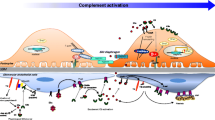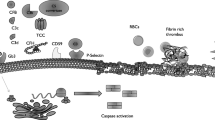Abstract
Haemolytic uraemic syndrome (HUS) remains the leading cause of acute renal failure in children. Although anEscherichia coli-produced verotoxin (VT) has been implicated in the pathogenesis of HUS, the precise mechanisms of disease are not well defined. We hypothesise that the pathogenesis of renal failure in HUS includes the binding ofE. coli VT to the glomerular mesangial cell, with consequent effects on renal function. Using human paediatric mesangial cells. we studied the binding and biological effects of the purified verotoxin VT-1. We isolated, purified and characterised paediatric glomerular mesangial cells. The mesangial cells were characterised by their immunoreactivity with both smooth muscle actin and vimentin antibodies, and lack of immunoreactivity with cytokeratin or factor VIII antibodies. Using an fluorescein isothiocyanate-conjugated VT (10−7–10−8 M), we demonstrated specific binding to the mesangial cell membrane by immunofluorescence microscopy. We also demonstrated a dose-dependent inhibition of mesangial cell mitogenesis at concentrations from 10−9 to 10−17 M. Our data demonstrate that VT-1 binds to paediatric human glomerular mesangial cells and this binding results in specific biological actions, including an inhibition of cell mitogenesis.
Similar content being viewed by others
References
Karmali MA, Petric M, Lim C, Fleming P, Arbus G, Lior H (1985) The association between idiopathic hemolytic uremic syndrome and infection by verotoxin producingEscherichia coli. J Infect Dis 151: 775–782
Richardson SE, Karmali MA, Becker LE, Smith CR (1988) The histopathology of the hemolytic uremic syndrome associated with verocytotoxin producingEscherichia coli infections. Hum Pathol 19: 1102–1108
Obrig TG, Louise CB, Lingwood CA, Boyd B, Barley-Maloney L, Daniel TO (1993) Endothelial heterogeneity in Shiga toxin receptors and responses. J Biol Chem 268: 15484–15488
Hoffman S (1993) Southwestern Internal Medicine Conference: Shiga-like toxins in hemolytic uremic syndrome and thrombotic thrombocytopenic purpura. Am J Med Sci 306: 398–406
Kaplan BS, Cleary TG, Obrig TG (1990) Recent advances in understanding the pathogenesis of the hemolytic uremic syndromes. Pediatr Nephrol 4: 276–283
Ausiello DA, Kreisberg JI, Roy C, Karnovsky MJ (1980) Contraction of cultured rat glomerular cells of apparent mesangial origin after stimulation with angiotensin II and arginine vasopressin. J Clin Invest 65: 754–760
Tanaka T, Fujiwara Y, Orita Y, Sasaki E, Kitamura H, Abe H (1984) The functional characteristics of cultured rat mesangial cells. Jpn Circ J 48: 1017–1029
Mené P, Simonson MS, Dunn MJ (1989) Physiology of the mesangial cell. Physiol Rev 69: 1347–1424
Matsell DG, Gaber LW, Malik KU (1994) Cytokine stimulation of prostaglandin production inhibits the proliferation of serum-stimulated mesangial cells. Kidney Int 45: 159–165
Khine AA, Lingwood CA (1994) Capping and receptor-mediated endocytosis of cell-bound verotoxin (Shiga-like toxin) 1: chemical identification of an amino acid in the B subunit necessary for efficient receptor glycolipid binding and cellular internalization. J Cell Physiol 161: 319–332
Foidart J, Dechenne C, Dubois C, Deheneffe J, Mahieu P (1981) Tissue culture of isolated renal glomeruli: present and fature. Adv Nephrol 10: 267–292
Calderwood SB, Auclair F, Donohue-Rolf A, Keusch GT, Mekalanos JJ (1987) Nucleotide sequence of the Shiga-like toxin genes ofEscherichia coli. Proc Natl Acad Sci USA 84: 4364–4368
Jackson MP, Neill RJ, OBrien AD, Holmes RK, Newland JW (1987) Nucleotide sequence analysis and comparison of the structural genes for Shiga-like toxin I and Shiga-like toxin II encoded by bacteriophages fromEscherichia coli 933. FEMS Lett 44: 109–114
Petric M, Karmali M, Richardson S, Cheung R (1987) Purification and biological properties ofE. coli verocytotoxin. FEMS Lett 41: 63–67
Endo Y, Tsurugi K, Yutsudo T, Takeda Y, Ogasawara T, Igarashi K (1988) Site of action of a Vero toxin (VT-2) fromEscherichia coli 0157:H7 and of Shiga toxin on eukaryotic ribosomes: RNAN-glycosidase activity of the toxins. Eur J Biochem 171: 45–50
Cleary TG (1988) Cytotoxin-producingEscherichia coli and the hemolytic uremic syndrome. Pediatr Clin North Am 3S: 485–507
Boyd B, Lingwood C (1989) Verotoxin receptor glycolipid in human renal tissue. Nephron 51: 207–210
Lingwood CA, Law H, Richardson S, Petric M, Brunton JL, De Grandis S, Karmali M (1987) Glycolipid binding of purified and recombinantEscherichia coli produced verotoxin in vitro. J Biol Chem 262: 8834–8839
Waddell T, Cohen A, Lingwood CA (1990) Induction of verotoxin sensitivity in receptor-deficient cell lines using the receptor glycolipid globotriosylceramide. Proc Natl Acad Sci USA 87: 7898–7901
Mangeney M, Lingwood CA, Taga S, Caillori B, Tursz T, Wiels J (1993) Apoptosis induced in Burkitt's lymphoma cells via Gb3/CD77, a glycolipid antigen. Cancer Res 53: 5314–5319
Mahan JD, Van Setten PA, McAllister C, Van den Heuvel LPWJ, Monnens LAH (1994) The human mesangial cell is a target for verotoxin-1 (VT-1) of the hemolytic uremic syndrome (HUS) (abstract). J Am Soc Nephrol 5: 835
Lingwood CA (1994) Verotoxin-binding in human renal sections. Nephron 66: 21–28
Foidart JM, Foidart JB, Vancauven-Berge P, Decoux M, Stul M, Lenaers A, Niebes P, Mathieu PR (1982) Synthesis of types I, III, IV and V (A, B) collagens by glomerular mesangial cells and aortic smooth muscle cells in culture. In: Moral F (ed) Biochemistry of renal function. Elsevier, Amsterdam, pp 23–34
Scheinman JI, Brown DM, Michael AF (1978) Collagen synthesis by human glomerular cells in culture. Biochem Biophys Acta 542: 128–136
Farquar MG, Wissig SL, Palade GE (1961) Glomerular permeability. I. Ferritin transfer across the normal glomerular capillary wall. J Exp Med 113: 47–66
Sterzel RB, Perfetto M, Bremesderfer D, Kashgarian M (1983) Disposal of ferritin in the glomerular mesangium of rats. Kidney Int 23: 480–488
Dzau VJ, Kreisberg JI (1986) Cultured glomerular mesangial cells contain renin: influence of calcium and isoproteronol. J Cardiovasc Pharmacol 8: S6-S10
Chansel D, Dussaule JC, Ardaillou N, Ardaillori R (1987) Identification and regulation of renin in human cultured mesangial cells. Am J Physiol 252: F32-F38
Lovett DH, Szamel M, Ryan JL, Sterzel RB, Gemsa D, Resch K (1986) Interleukin 1 and the glomerular mesangium. I. Purification and characterization of a mesangial cell-derived autogrowth factor. J Immunol 136: 3700–3705
Werber HF, Emancipator SN, Tykocinski ML, Sedor JR (1987) The interleukin 1 gene is expressed by rat glomerular mesangial cells and is augmented in immune complex glomerulonephritis. J Immunol 138: 3207–3212
Aron DC, Rosenswerg JL, Abboud HE (1989) Synthesis and binding of insulin-like growth factor 1 by human glomerular mesangial cells. J Clin Endocrinol Metab 68: 585–591
Conti FG, Striker LJ, Elliott J, Andreani D, Striker GE (1988) Synthesis and release of insulin-like growth factor 1 by mesangial cells in culture. Am J Physiol 255: F1214-F1219
Abboud HE, Poptic E, Dicorleto P (1987) Production of platelet derived growth factorlike protecin by rat mesangial cells in culture. J Clin Invest 80: 675–683
Kreisberg JI, Karnovsky MJ, Levine L (1982) Prostaglandin production by homogeneous cultures of rat glomerular epithelial and mesangial cells. Kidney Int 22: 355–359
Scharschmidt LA, Dunn MJ (1983) Prostaglandin synthesis by rat glomerular mesangial cells in culture. Effects of angiotensin II and arginine vasopressin. J Clin Invest 71: 1756–1764
Mené P, Cinotti GA, Pugliese F (1992) Signal transduction in mesangial cells. J Am Soc Nephrol 2: S100-S106
Hannun YA, Linardic CM (1993) Sphingolipid breakdown products: antiproliferative and tumor-suppressor lipids. Biochem Biophys. Acta 1154: 223–236
Kolesnick RN (1991) Sphingomyelin and derivatives as cellular signals. Prog Lipid Res 30: 1–38
Author information
Authors and Affiliations
Rights and permissions
About this article
Cite this article
Robinson, L.A., Hurley, R.M., Lingwood, C. et al. Escherichia coli verotoxin binding to human paediatric glomerular mesangial cells. Pediatr Nephrol 9, 700–704 (1995). https://doi.org/10.1007/BF00868715
Received:
Revised:
Accepted:
Issue Date:
DOI: https://doi.org/10.1007/BF00868715




